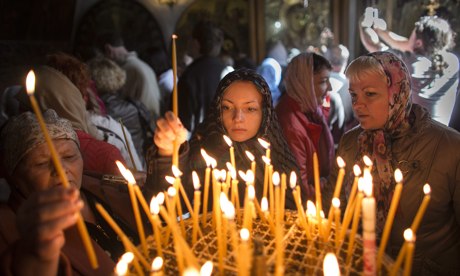
Graffiti and selfies record pilgrims' progress at Bethlehem shrine
Academics are only now studying messages and paintings on the Church of the Nativity's columns dating back to the Crusades
________________________________________________________________Matthew Kalman in Bethlehem
The Guardian, Monday 23 December 2013
________________________________________________________________

Pilgrims
light candles in the Church of the Nativity, in the West Bank town of
Bethlehem, the supposed birthplace of Jesus. Photograph: Oliver
Weiken/EPA
Most
visitors to the Church of the Nativity head straight for the grotto
beneath the altar where, according to tradition, Jesus was born 2014
years ago. But among the throng of pre-Christmas pilgrims this year,
Karen Stern, a historian at Brooklyn College, City University of New
York, was more interested in the six-metre-high columns built to support
the roof by the Emperor Justinian in the sixth century.
In
the gloom of the ancient nave, Stern's torch picks out hundreds of tiny
crosses scratched into the four rows of columns – a common practice of
ancient pilgrims who wanted to make their mark on the holiest shrines in
Christendom – long before Banksy helped transform the walls of
Bethlehem into a canvas for world-class street art.
Almost
invisible against the white-veined red stone, close inspection reveals
hundreds of messages scrawled in ink from floor level to high on the
columns, which have only come to the attention of scholars this year.
Much
of the graffiti is more suited to a park bench than the birthplace of
Jesus. Mazen and Mustafa simply wrote their names. Hassan signed each of
the 44 columns with an artistic flourish. MAH tagged a column in 1940,
just above YM, who visited in 1938. GS Diek signed off in English and
Arabic in 1930.
The
prayers are interspersed with scribbled passages from the Bible and
Qur'an. "God remember me," is written in the stonework in several
scripts and tongues. Ibrahim offers a prayer for his beloved wife, Suad,
hoping she will have a happy life and that they will be "together for
ever".
"Here
in this blessed place, I write this in my own hand," proclaims B'shara
Ibn al-Wafi, praying to God for the protection and prosperity of 21
family members. His prayer is undated, but the archaic names
painstakingly listed suggest it is not recent.
There
are more messages on the marble facing of the Holy Nativity grotto
beneath the altar. "God have mercy on me, I am a sinner, Deacon
Suleiman, 1960," confessed a Lebanese priest near the exit from the
grotto in the Armenian chapel dedicated to the Magi. "God remember your
servant Yusef and have mercy on his parents," says a prayer chiselled
into the marble.
More prosaically, a wall nearby is covered with names of foreign visitors like a noticeboard in a backpackers' hostel.
"In
the west today people are used to seeing graffiti as a type of
defacement," said Stern, who has studied religious graffiti in Middle
Eastern shrines, including a third-century building from Dura Europos in
Syria that may be the oldest-known church prototype. "When you see
graffiti in these shrines and pilgrimage sites, you realise that it's
actually something quite different. People are literally leaving their
marks in these places to be somehow witnessed by the divine and other
worshippers," she said.
"It
appears to be a sanctioned practice – not vandalism. People are going
to these specifically religious places to write 'remember me'. It's very
poignant and simple. This is graffiti as a form of veneration."
High
on the columns are Crusader-era paintings depicting Jesus, the holy
family and the saints. Beneath the Virgin Glykophilousa, an 1130
painting of a tenderly mothering Mary and infant Jesus, medieval
pilgrims commissioned the original selfies – freelance votive images of
themselves at prayer. The medieval French Crusader Lord de Coucy painted
his family crest on a column sometime in the 12th century. There is
another medieval coat of arms etched on the wall of the Chapel of
Joseph, beneath the Catholic section of the church.
Lisa
Mahoney, a medieval art historian at DePaul University, says there is
a link between the centuries-old paintings high on the columns and the
modern graffiti below.
"When
people visited a place like this, a church that marked the site of a
sacred event, it was important to them that they left some physical
trace of their visit behind," Mahoney said. "This is the place where the
divine entered the world so it makes it a special place for
communicating with the divine. It's a place where there's been a real
meeting of the earthly and heavenly realms."
Historians
have noted the Crusader artwork, but the graffiti has so far attracted
scant attention. Stern said it illuminates the life and practices of
ordinary souls discarded by history. "We have these small voices from
the past that otherwise would totally disappear," she said.
No comments:
Post a Comment